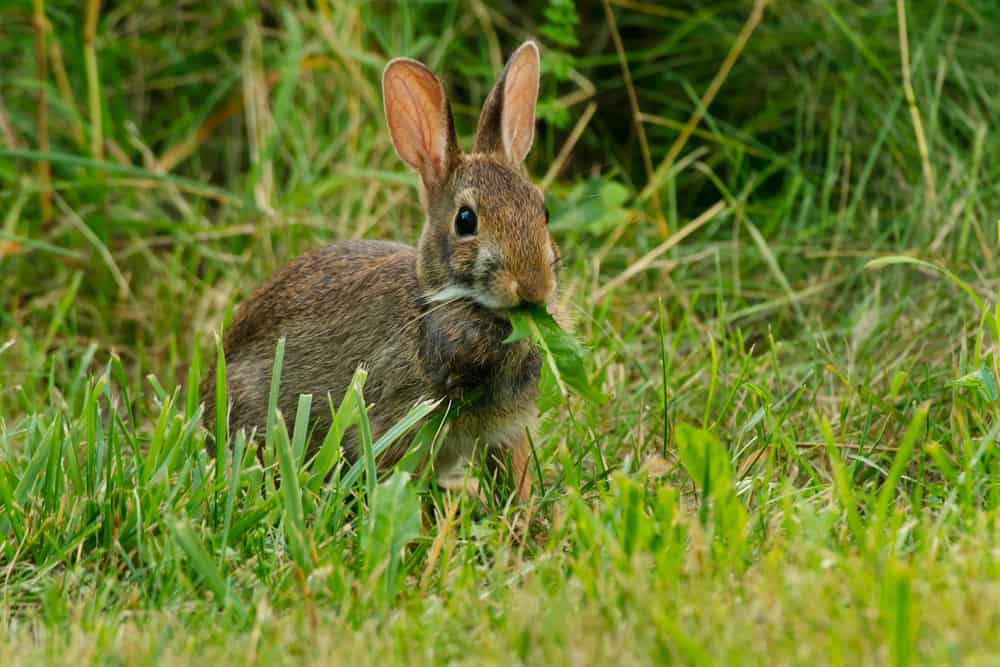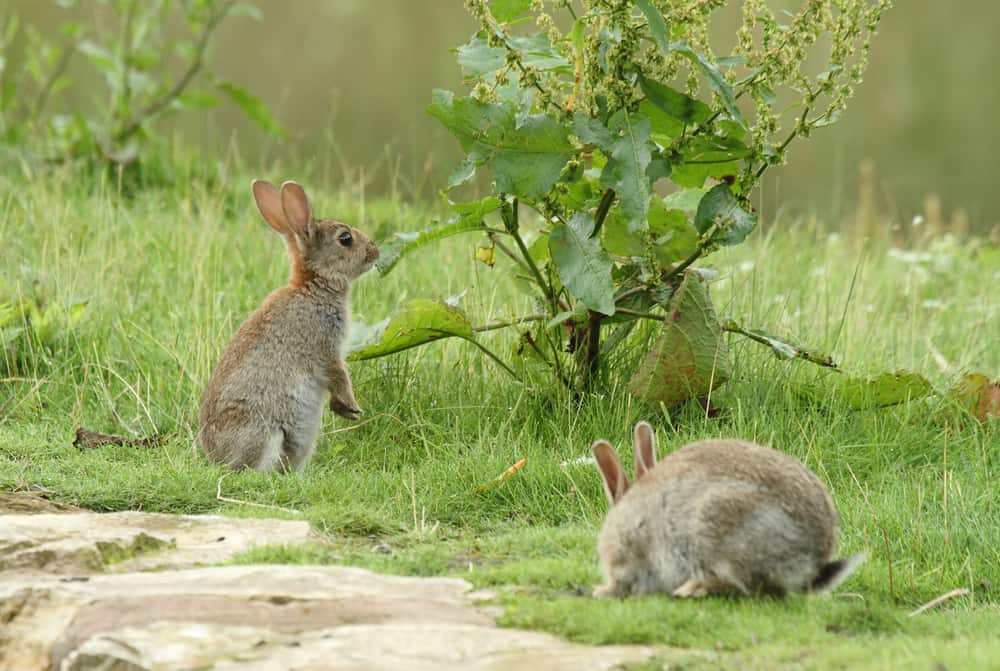What to Feed Wild Cottontail Rabbits
Wild rabbits are just as adorable as any other rabbit. They have the most beautiful fluffy fur, long ears, and tiny cottontails. You've heard of them in tales told to you as a child, especially about their speed and supposed love for carrots.
What do wild rabbits eat? Here you'll get to know.
Wild Rabbits Habits And Biology
Rabbits, bunnies, or bunny rabbits are ground-dwelling mammals that can be found all over the world. The most common wild rabbit is the European rabbit (Oryctolagus cuniculus). All breeds of domestic rabbits originate from the European rabbit (cottontail).
Most wild rabbits, especially in America, are brown with white tails. Rabbits' coats are agouti in color. That is, each strand of hair is multicolored. This adaptation enables the rabbits to blend into their environments as well as hide from predators.
The position of the wild rabbits' eyes on its skull gives it a wild field of view. They have a 360o view and can easily spot incoming predators coming from whatever direction.
Bunny rabbits that live in cooler climates have longer ears compared to those living in cooler areas. Their long ears prevent them from losing heat. The opposite applies to those living in cooler areas.
Their ears also aid them in maintaining balance and movement when running from predators. In addition, rabbits' long ears also help them detect and avoid incoming threats.

Wild rabbits are herbivores that mainly graze on grass and other leafy products. They are nocturnal, which means they are primarily active in the late afternoons and sometimes during the night.
In captivity, wild rabbits sleep for about four to eight hours. Do you know that rabbits sleep with their eyes open? This allows them to react to any sudden movements and respond to potential danger.
Unlike other rabbit species that occupy burrows (holes) underground, wild rabbits like the cottontails nest above ground. They use different components to construct their nests, such as bits of fur they pull out from their coats. They also use leaves and grasses to complete their nests.
Wild rabbits live solitary lives and are territorial by nature. Although sometimes, they occupy the same area for short periods.
What Do Wild Rabbits Eat In The Wild?
Being herbivores, wild rabbits primarily feed on vegetation. When it comes to their stomachs, they tend to keep strict feeding schedules. They usually eat first thing at daybreak, followed by the early hours of the evening.
In the wild, wild rabbits indulge In different foods depending on the seasons of the year. Throughout this time, their plant diet is still maintained.
Most of the foods bunnies consume in the wild are tough to digest, but rabbits are uniquely adapted to solve this problem. They digest food through a process known as hindgut fermentation—this is whereby the hard-to-digest plant material is broken down in the presence of bacteria.
Furthermore, they pass two particular types of droppings. The first kind is known as hard droppings, and the second is soft droppings. The night droppings are re-eaten immediately after excretion.
Unlike cows and other herbivores that chew cud to prevent the loss of nutrients, wild rabbits extract sufficient nutrients from their night droppings.
Even though they feed on various vegetation, wild rabbits are very picky eaters when it comes to what goes into their bellies. They prefer fresh foliage (leaves and plants collectively) to dry plants. A large number of wild rabbits are known to climb trees to access fresh leaves and vegetation. They enjoy feeding on delicate plants.
In warmer seasons, rabbits will eat:
- Grasses –contain various nutrients, vitamins, and fiber that aid in the digestion of food.
- Flowers and wildflowers –such as jasmine, willows, and roses are enjoyed by wild rabbits.
- Clovers – the whole plant is consumed, including the stem, leaves, and flowers.
- Weeds – such as buttercups, daisies, and dandelions are included in wild rabbits diets.
- Vegetable plants –examples include kales, spinach, and raspberry leaves.
- Tree seedlings –like broccoli, beans, and lettuce are eaten by bunnies.
In drier seasons, wild rabbits will indulge in foods like:
- Twigs –wild rabbits mostly gnaw on them to regulate the size of their teeth.
- Tree bark –rabbits will consume the soft parts and even twigs to aid in digestion.
- Pine needles –ordinary pine needles are not harmful to rabbits though they are spiky and sharp.
- Buds
- Dry and green grasses
- Leafy weeds
- Shrubs
What Do Wild Rabbits Eat As Pets?

The wild rabbit's diet living in the wild and kept as a pet is not so different. You can feed rabbits most food items they consume in the wild when you keep them as pets.
Despite this fact, wild rabbits kept as pets are also happy to indulge in foods consumed by pet rabbits. Even though they can be kept as pets, it's always wise to release them back into the wild as early as possible.
This is done so they don't get accustomed to the domesticated life. Their lifespan is usually shorter in captivity. They may die from stress either from excessive handling or not being with their own kind. Before caring for a wild rabbit, it is crucial to find out if they are orphans.
That said, some foods wild rabbits eat in captivity include:
- Hay –some of the best options to feed wild bunnies are hay like clover hay, meadow hay, Timothy hay, orchard hay. Hay should make up at least eighty percent of their diets.
- Flowers –sunflowers, daisies, yarrow, clovers, and dandelions are great additions to the rabbit's diet.
- Vegetables –examples that should be fed to the bunnies include kale, cabbage, collard greens, carrot tops, and dandelion leaves. These are but a few examples essential for a bunnies diet.
- Fruits –such as raspberries, apples, blueberries, and strawberry tops provide essential nutrients for their development. However, they should not be fed regularly.
- Alfalfa hay (Lucerne) –is richer in proteins and minerals in comparison to grass hays. It is beneficial to young rabbits. It's helpful to young rabbits that are underweight or recovering from an illness.
On the flip side, feeding it to adults as a primary source of hay is not recommended. This is because it has high calcium contents that may cause bladder stones (solid growths from proteins and minerals).
Tips To Feeding Wild Rabbits
When you spot a wild rabbit in your yard, you may be tempted to start feeding it. Although it's not advisable to feed wild animals, knowing how and what to feed a wild rabbit may come in handy. At least for the rabbit's sake.
That said, here are some tips to consider when feeding wild rabbits:
Pick a location in your yard to place the food. You can set up an area where the wild bunnies can eat. Since these rabbits like bushy edges of particular areas, consider setting up a small bush pile near the edge of your garden or yard.
- When rabbits enjoy eating weeds and grasses during the warmer seasons, leave a section of your lawn partially uncut. This practice, in turn, allows grass and weeds to grow, providing a suitable area for the wild rabbits to eat.
- When rabbits eat more barks and twigs in colder seasons, make a small pile of these items in a section of your yard.
Provide grass and hay for the wild rabbits. As previously mentioned, grass and hay serve as a staple food for the wild rabbit's diet. Besides the readily available grass on your lawn, you can purchase hay to feed them.
- Avoid using pesticides in your yard if you wish to feed wild rabbits, as they could make them sick.
Put out pelleted rabbit food for your wild rabbits. Pellets, especially those with seeds, serve as an excellent nutritional source for rabbits.
- The pellets should be fed to the wild rabbits in moderation as they are nutrient-dense.
- Pelleted rabbit food can be bought at your local pet store.
Feed the wild rabbits fruits and veggies. Provide them with at least three different greens per feeding, including one high in vitamin A. You can provide the wild rabbits in your garden with veggies such as:
- Beet greens and collard green – are rich in vitamin A.
- Broccoli –just the leaves and stems are healthy for the wild rabbits.
- Carrots –should be fed in small amounts as they are rich in carbohydrates which are not easily digestible.
- Brussel sprouts.
- Watercress
When you follow these simple steps, you might be helping these wild rabbits make it through tough times. It is, however, not recommended that you take in wild rabbits as pets.
Frequently Asked Questions (FAQs)
Do rabbits drink water?
Yes. Rabbits, like all other mammals, require water to survive. A big part of their bodies is made of water.
Do rabbits bite human beings?
Rabbits don't usually bite humans. When they do, it might be due to shock from an action such as suddenly grabbing them.
Summary
Wild rabbits are amazing creatures built for survival in the wild. Feeding them is helpful, but they thrive better in their natural environment.
You require an immense amount of knowledge to care for them. Help them but don't get too attached. Set them free after as soon as they are capable of fending for themselves.
Source: https://www.atshq.org/what-do-wild-bunnies-eat/
0 Response to "What to Feed Wild Cottontail Rabbits"
Post a Comment